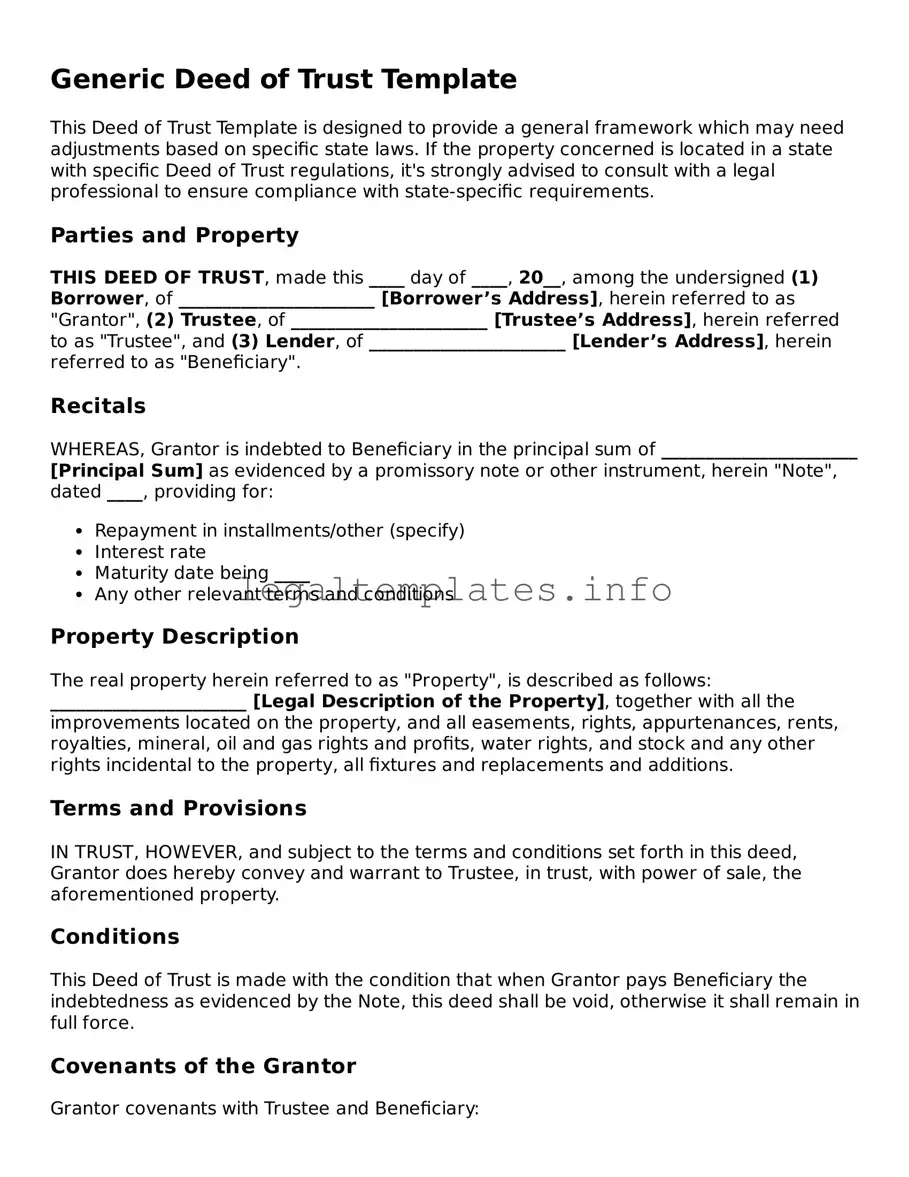Generic Deed of Trust Template
This Deed of Trust Template is designed to provide a general framework which may need adjustments based on specific state laws. If the property concerned is located in a state with specific Deed of Trust regulations, it's strongly advised to consult with a legal professional to ensure compliance with state-specific requirements.
Parties and Property
THIS DEED OF TRUST, made this ____ day of ____, 20__, among the undersigned (1) Borrower, of ______________________ [Borrower’s Address], herein referred to as "Grantor", (2) Trustee, of ______________________ [Trustee’s Address], herein referred to as "Trustee", and (3) Lender, of ______________________ [Lender’s Address], herein referred to as "Beneficiary".
Recitals
WHEREAS, Grantor is indebted to Beneficiary in the principal sum of ______________________ [Principal Sum] as evidenced by a promissory note or other instrument, herein "Note", dated ____, providing for:
- Repayment in installments/other (specify)
- Interest rate
- Maturity date being ____
- Any other relevant terms and conditions
Property Description
The real property herein referred to as "Property", is described as follows: ______________________ [Legal Description of the Property], together with all the improvements located on the property, and all easements, rights, appurtenances, rents, royalties, mineral, oil and gas rights and profits, water rights, and stock and any other rights incidental to the property, all fixtures and replacements and additions.
Terms and Provisions
IN TRUST, HOWEVER, and subject to the terms and conditions set forth in this deed, Grantor does hereby convey and warrant to Trustee, in trust, with power of sale, the aforementioned property.
Conditions
This Deed of Trust is made with the condition that when Grantor pays Beneficiary the indebtedness as evidenced by the Note, this deed shall be void, otherwise it shall remain in full force.
Covenants of the Grantor
Grantor covenants with Trustee and Beneficiary:
- To pay the indebtedness as described in the Note.
- To pay all taxes, assessments, charges, fines, and impositions attributable to the Property which may attain a priority over this Deed of Trust, and to provide proof of payment upon request.
- To maintain the Property in good condition and repair, not commit waste on the Property, and comply with all laws, ordinances, regulations, and covenants applicable to the Property.
- To promptly notify Beneficiary of any proceeding that may significantly affect the Property’s value.
- To provide and maintain insurance on the Property as required by Beneficiary.
Additional Provisions
In addition to the above, the following provisions shall apply:
[Insert any additional provisions here]
Execution
IN WITNESS WHEREOF, the parties have caused this Deed of Trust to be executed as of the day and year first above written.
______________________ [Signature of the Borrower]
______________________ [Signature of the Trustee]
______________________ [Signature of the Lender]
